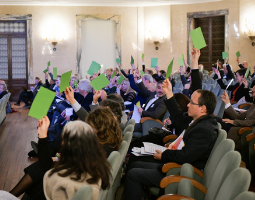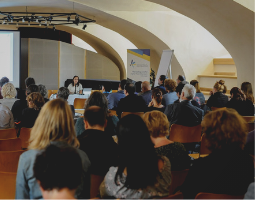Bosnia and Herzegovina National Overview
Updated in November 2016 by Maja Ackar Zlatarevic, Vice-Dean for International Relations at the Academy of Music, University of Sarajevo.
Overview of Higher Music Education System
Music education in Bosnia and Herzegovina is divided in three levels:
- primary music education, parallel with education in primary schools, 6 years of Music training
- secondary music education, could be both parallel, or regular, 4 years
- high music education at Academies of Music
| Total number of institutions |
There are 5 high music institutions, 4 state and 1 private:
|
| Total number of music students |
ca. 1000
|
| Funding | Public Academies are for 100% funded by government, tuition fees (some students pay for their studies in case government hasn’t provided these places; all students at doctoral studies pay the fee), and private academies are funded by the tuition fees, donations etc. |
| Curricula |
Curricula are provided by each Academy and verified by Universities and Ministries if Education. Students are trained to work as teachers in primary and secondary music schools, as teachers of instruments, ear training, choir and orchestra conductors, and as music teachers in regular primary and secondary schools. Lessons are provided individually for instrument lessons and group lessons are given for all other subjects. Academy of Music Sarajevo, the oldest institution of its kind in Bosnia and Herzegovina offers studies in:
|
| Genres |
Art classical music, traditional music, jazz and musical (as elective subjects).
|
| 2-cycle system |
The high music education is divided as follows:
First cycle studies take 4 years, master one year, and the thirty cycle is 3 years. (4+1+3)
|
| Qualifications |
The diplomas are issued by Universities and are the same for all faculties within one of the Universities. The studies are organized according to Bologna system and the curricula is harmonized with European standards. Diplomas are issued as follows:
|
| Entry requirements 1st cycle |
All students are obliged to pass the entering exams designed for each department, or line of studies.
|
| Entry requirements 2nd cycle |
All students are obliged to pass the entering exams designed for each department, or line of studies.
|
| % of students who continue with 2nd cycle | ca. 60% at Academy of Music Sarajevo |
| 3rd cycle | Academy of Music Sarajevo is the only HMEI offering 3th cycle studies in Bosnia and Herzegovina. Candidates can do both artistic research and theoretical research. The studies last three years and bring 180 ECTS. |
| Credit point system |
At all three faculties a credit point system, compatible with ECTS, is used.
|
| Internationalization |
Most of the internationalization that takes place at the Music Academies in Bosnia and Herzegovina is Erasmus mobility. Both the Academy of Music Sarajevo and the Academy in Banjaluka implement it. Internationalization is one of the most important issues for Academy of Music Sarajevo. Since other institutions are rather young, internationalization strategies are still being developed. Nonetheless, international activities take place, such as the International Accordion Fest in East Sarajevo and the international symposium “Vlado Milosevic” in Banjaluka. Internationalization is one of the most important issues for Academy of Music Sarajevo. Its value is not only recognized by exchange is students and teachers, but as well as harmonizing with EU standards and procedures.
|
| Quality assurance |
Unfortunately, none of our study programs have been accredited yet. There is a National agency for Quality in HE. Together with external experts they should do the process of accreditation.
|
| Employability | There are almost no unemployed music graduates. |
| Academic Year |
Academic year starts on October 1st and finishes on September 30th. It is divided in two semesters. The first semester starts in October and ends in January, the second starts in February and ends in June. Exams are organized in January/February and June/July. Entering exams for the first cycle are organized in July and September, for second cycle in September and third cycle in the beginning of October.
|
The primary music schools offer music education for children from age 8-15, with instrument lesson, solfeggio, choir and orchestra lessons. Instrument lessons are always given individually. At entering exam to primary music school, children of age 8, are asked to sing a song they want to, repeat tones played on piano and repeat some short rhythm forms. That way teachers can find out do children have any natural potential to learn instruments and music. All children apply for a specific instrument.
Secondary music schools offer music education and are completely independent because they offer the regular education together with music subjects, such as instruments, chamber music, solfeggio, harmony, counterpoint, history of music, choir, orchestra, etc. Students are between age 15 and 19. Instrument lessons are given one to one. Other subjects are organized as group lessons. At entering exam for secondary music candidates need to perform specific pieces for instruments and pass the solfeggio exam. With piano as main subject for example, two voices inventions from Bach, Sonata from Mozart/Haydn, Exudes and a romantic piece need to be performed If the candidate hasn’t attended primary music schools he/she can only start as pupil at music and theory department, after passing the entering exams
Types of Pre-College Education |
|
| Music School |
40 primary music schools and 14 secondary music schools
|
| Private Music School |
3 private music schools
|
| Private Tuition |
Private lessons are given by professors to students.
|
Additional Information |
|
|
There are seminars, master classes, summer and winter schools organized for our students. They can as well take part in all of these abroad. |
|
| Music and Arts in General Education |
In regular schools, children receive 1 lesson per week in primary schools during 9 years, and only 1 lesson per week for 1 year in Gymnasium.
|
| Students entering Higher Music Education |
Students usually come from secondary music schools and some of them from gymnasium.
|
| Special Facilities for Talented Students at Pre-College Level |
There are national competitions. Students as well go to international competitions.
|
Overview of Music Teacher Education System
The HME system in Bosnia and Herzegovina provides all of our students to become teachers, either in music or general schools. All the students attend lessons of pedagogy and methodology, and by having these passed, according to our legislative they are allowed to work in schools.
Instrumental/Vocal Music Teacher Education |
|
| Institutions | The education is provided at academies of music, which are the part of Universities. The issued diplomas are the same as any others at university level. |
| Structure and Curriculum |
Studies are organized in 3 cycles:
|
| Genres |
Classical music (since one can get a diploma as a classically trained musician only)
|
| Internationalization |
Students can benefit from mobility programs, attend master classes and summer/winter classes abroad, take part in international projects, etc.
|
| Employability |
Students are trained to work as instrument teachers both in primary and secondary music schools. They are given the diploma of bachelor, or master, depending on which cycle they have finished. These diplomas are relevant for employees.
|
| Continuing Professional Development (CPD) |
Students can continue their education at music academies, there’re seminars organized by Centre for music pedagogy of Academy of Music Sarajevo, etc.
|
Education for Music Teacher in General Education (primary and secondary school) |
|
| The HME system in Bosnia and Herzegovina provides all of our students to become teachers, either in music or general schools. All the students attend lessons of pedagogy and methodology, and by having these passed, according to our legislative they are allowed to work in schools, therefore see above. | |





